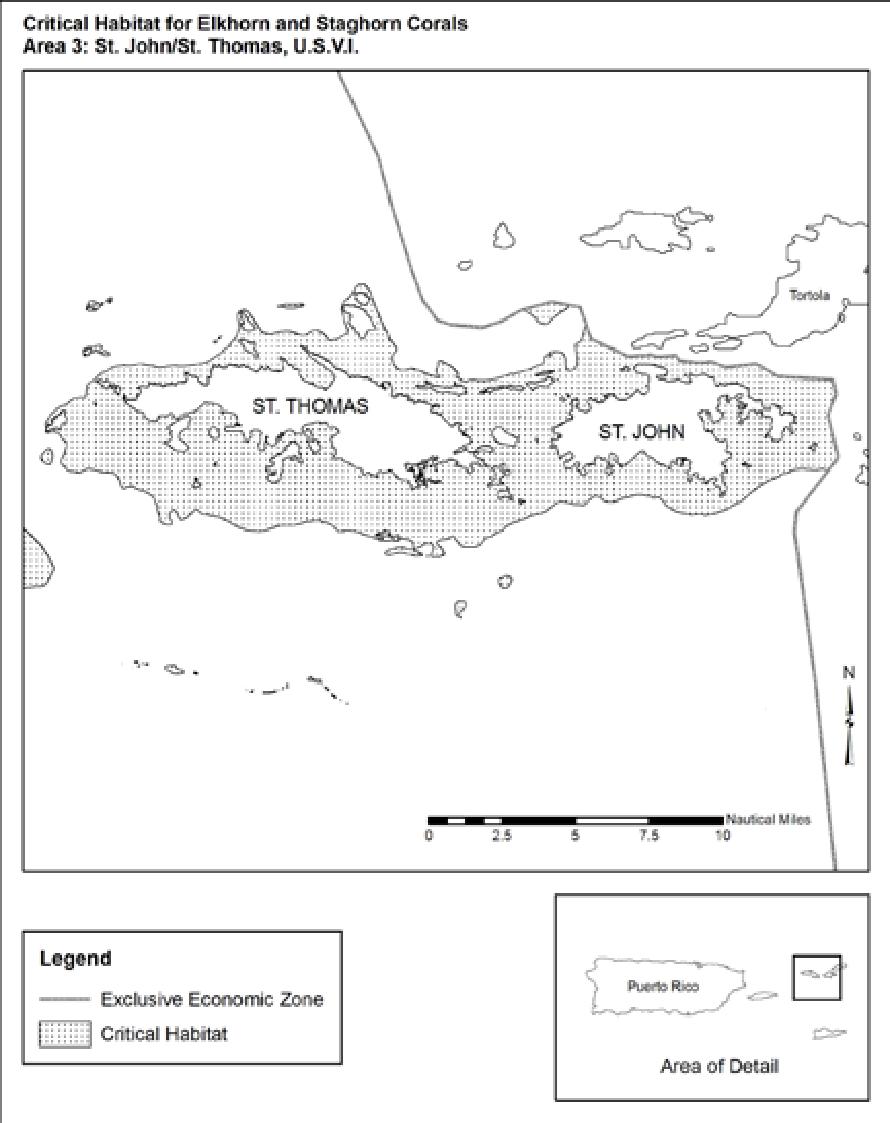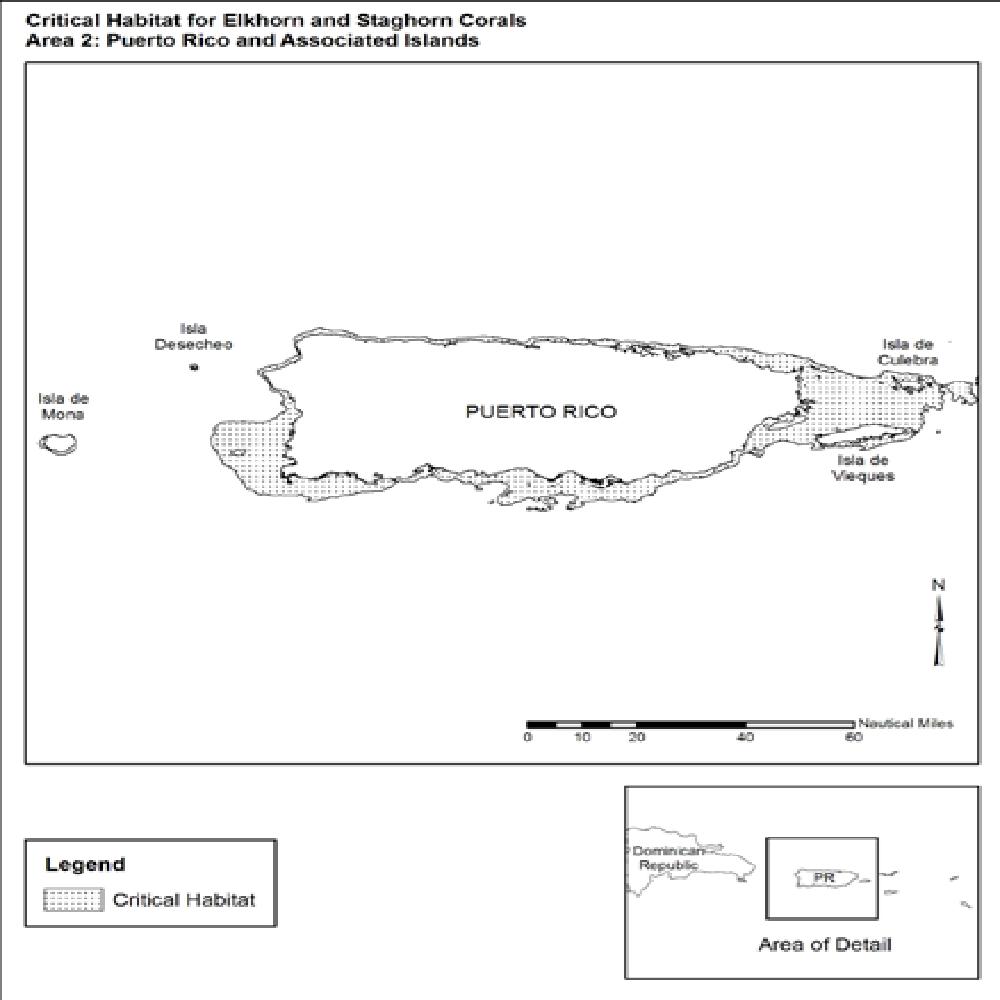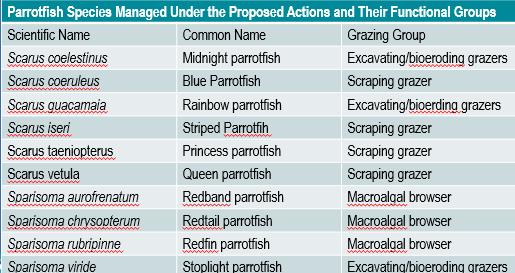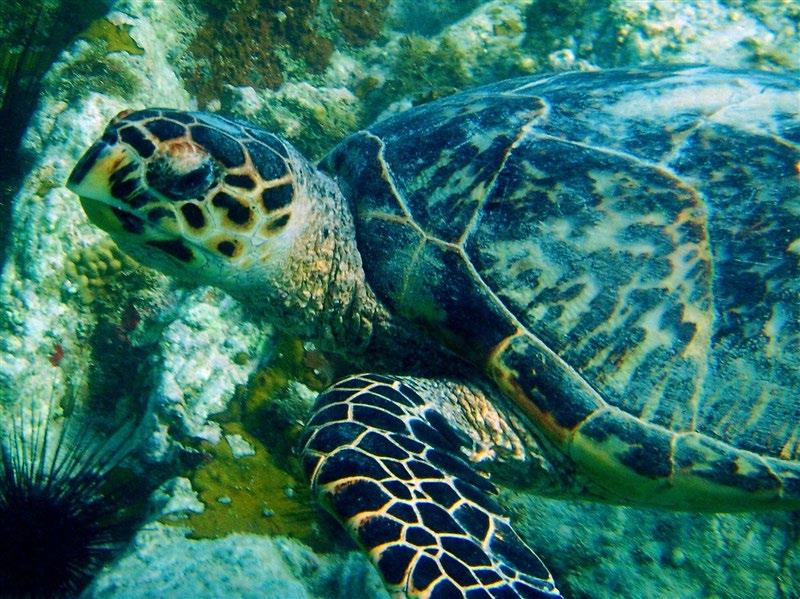SERO
An Overview of the Endangered Species Act Batched Biological Opinion on the 3 Island-Based Fishery Management Plans and the Opinion’s Incidental Take Statement
182nd Caribbean Fishery Management Council Meeting
August 15-16, 2023
Jennifer Lee
Protected Resources Division
Jennifer.Lee@noaa.gov

What is a Biological Opinion?
The analytical end product of a formal section 7 consultation that:
• Summarizes the effects of a Federal “action” on ESA-listed species and/or designated critical habitat that may be affected.
• Identifies NOAA Fisheries’ conclusion of whether or not the action is likely to jeopardize the continued existence of any ESA-listed species or result in the destruction or adverse modification (DAM) of any critical habitat of such species.
• Represents the opinion of NOAA Fisheries and considers technical, legal, and policy issues relative to the proposed action.
NOAA Fisheries has dual responsibilities as the both the Action agency under MSA and the consulting agency under the ESA.
For the purposes of the consultation, SERO Sustainable Fisheries Division is considered the action agency and SERO Protected Resources Division the consulting agency.

U.S. Department of Commerce | National Oceanic and Atmospheric Administration | NOAA Fisheries | Page 2
Components of the Biological Opinion

U.S. Department of Commerce | National Oceanic and Atmospheric Administration | NOAA Fisheries | Page 3 Introduction p. 6-7 Section 1 Consultation History p. 8 Section 2 Proposed Actions and Action Areas p. 9-32 Section 3 Status of the Species and Critical Habitat p. 33-125 Section 4 Environmental Baseline p. 126-144 Section 5 Effects of the Action p. 145-186 Section 6 Cumulative Effects p. 187-188 Section 7 Jeopardy/Destruction or Adverse Modification Analyses* p. 189-230 Section 8 Conclusion p. 231 Section 9 Incidental Take Statement p. 232-243 Section 10 Conservation Recommendations p. 244-245 Section 11 Reinitiation of Consultation p. 246 Section 12 Literature Cited p. 247-298
Proposed Action and Action Areas

• Evaluated three separate actions batched in one Biological Opinion:
o The Comprehensive FMP for the Puerto Rico EEZ (Puerto Rico FMP).
o The Comprehensive FMP for the St. Thomas/St. John EEZ (St. Thomas/St. John FMP).
o The Comprehensive FMP for the St. Croix EEZ (St. Croix FMP). • Evaluated the effects of approving and implementing each FMP, including the operation of each fishery as managed under its respective then-proposed FMP and implementing regulations.
U.S. Department of Commerce | National Oceanic and Atmospheric Administration | NOAA Fisheries | Page 4
Status of Species in the Action Area
Marine Mammals
• Fin whale (E*)
• Sei whale (E)
• Sperm (E)
Corals
• Elkhorn (T**)
• Staghorn (T)
• Rough-cactus (T)
• Pillar (T)
• Lobed Star (T)
• Mountainous star (T)
• Boulder star (T)
Sea Turtles
• Loggerhead NWA DPS*** (T)

• Green, NA and SA DPSs (T)
• Hawksbill (E)
• Leatherback (E) Fish
• Giant Manta Ray (T)
• Nassau grouper (T)
• Oceanic whitetip shark
• Scalloped hammerhead (Central and Southwest DPS)
*E=Endangered
**T=Threatened
***DPS= Distinct Population Segments
Underlined=Likely to be Adversely Affected
U.S. Department of Commerce | National Oceanic and Atmospheric Administration | NOAA Fisheries | Page 5
Critical Habitat in the Action Area
Species Unit(s)
Green sea turtle Culebra Island
Hawksbill
sea turtle Mona and Monita Island
Leatherback
sea turtle
Staghorn and elkhorn
corals =Likely to Be
Adversely affected

Sandy Point, St. Croix, U.S. Virgin Islands,
Area 2: Puerto Rico and Associated Islands


Area 3: St. John/St. Thomas, U.S. Virgin Islands, and Area 4: St. Croix, U.S. Virgin Islands

U.S. Department of Commerce | National Oceanic and Atmospheric Administration | NOAA Fisheries | Page 6
Effects From the Proposed Actions
• Anticipated adverse effects stem from:
o Capture and/or entanglement in fishing gear or physical impacts from the gear; that could adversely affect them;

o Vessel activity (boat strikes to sea turtles; anchoring to corals and Acropora critical habitat); and
o Harvest of herbivorous reef fish (to Acropora critical habitat and ESA-listed coral species only.
• Estimated the number and amount of each species that is likely to be incidentally affected or affected in the future, and the amount of Acropora critical habitat likely to be affected.
• Evaluated effects relating to dynamics of herbivorous fish, algae, and coral and Acropora critical habitat.
U.S. Department of Commerce | National Oceanic and Atmospheric Administration | NOAA Fisheries | Page 7
Data Limitations and Sources
• While our Opinion is based on the best available scientific and commercial information, we acknowledge data source limitations throughout the document (e.g., see p146).
• Primary Data Sources for Estimating Interactions
o For sea turtles:
o Strandings (see p. 148), # of fishing trips (for vessel strike analyses).
o For ESA-listed fish:

o 2012-2018 commercial and recreational landings records.
o For corals:
o Number of traps (fish and lobster) in federal waters, average size of traps, the percentage of those traps reported to be used in coral or hard-bottom areas, and the total area of coral cover.
U.S. Department of Commerce | National Oceanic and Atmospheric Administration | NOAA Fisheries | Page 8
Jeopardy/DAM Analyses

• Assessed each species’ population-level response to the effects of the action and whether those effects of the proposed action, when considered in the context of the status of the species (Section 3), the environmental baseline (Section 4), and the cumulative effects (Section 6), are likely to jeopardize their continued existence in the wild.
• Considered the extent to which the proposed actions are likely to result in destruction or adverse modification of coral critical habitat.
U.S. Department of Commerce | National Oceanic and Atmospheric Administration | NOAA Fisheries | Page 9
Conclusion
“After reviewing the current status of the species, the environmental baseline, the effects of the proposed actions, and cumulative effects using the best available data, it is NMFS’s biological opinion that the proposed actions are not likely to jeopardize the continued existence of the NA DPS green sea turtle, SA DPS green sea turtle, hawksbill sea turtle, Nassau grouper, oceanic whitetip shark, the Central and Southwest Atlantic DPS of scalloped hammerhead shark, elkhorn coral, staghorn coral, rough cactus coral, pillar coral, lobed star coral, mountainous star coral, or boulder star coral, or result in the destruction or adverse modification of designated Acropora critical habitat.”

U.S. Department of Commerce | National Oceanic and Atmospheric Administration | NOAA Fisheries | Page 10
Incidental Take Statements (ITS)
• Specifies the amount or extent of take.
• Defines reasonable and prudent measures (RPMs) and terms and conditions(TCs) for their implementation.
• Complying with the terms and conditions of an ITS exempts the Federal agency from take prohibitions.

U.S. Department of Commerce | National Oceanic and Atmospheric Administration | NOAA Fisheries | Page 11
THE INCIDENTAL TAKE STATEMENT: TAKE ESTIMATES OVER 3-YEAR PERIODS
*From any combination of the NA SA DPSs
**Non-lethal take resulting from effects to corals from the harvest of herbivorous fish (lost grazing capacity), monitored via a take proxy (.ie. the biomass of certain species/functional groups)

“ U.S. Department of Commerce | National Oceanic and Atmospheric Administration | NOAA Fisheries | Page 12
SPECIES LETHAL (Turtles/Fish=individuals; coral=ft2) NON-LETHAL PR FMP St. Thomas/St John FMP St. Croix FMP Same for Each Green sea turtle* 6 9 3 0 Hawksbill sea turtle 6 0 3 Scalloped hammerhead shark 0 0 3 0 Nassau grouper 0 12 0 0 Oceanic whitetip shark 33 48 6 0 Elkhorn coral 619.5 116 195 ** Staghorn coral 566.7 801 19.2 ** Rough cactus coral 36.6 69.3 12 ** Pillar coral 89.1 367.8 8.4 ** Lobed star coral 420.9 32,793.3 1,305 ** Mountainous star coral 982.8 26,802.3 581.4 ** Boulder star coral 510.6 52,175.7 1,243.8 **


U.S. Department of Commerce | National Oceanic and Atmospheric Administration | NOAA Fisheries | Page 13
“For the purpose of the ITS, our take proxy to biomass is more accurately defined as Relative Biomass, i.e., the numbers of fish relative to numbers observed previously. The relative biomass values will be estimated using the visual census data, and subsequent values can be used to infer a relative increase or decrease in biomass detected via those surveys over time.”
Incidental Take Statement (ITS)
• Specifies the amount or extent of take that is anticipated.
• Defines Action Agency Requirements

o Reasonable and prudent measures (RPM)
o Terms and conditions for RPM implementation
• Complying with the terms and conditions of an ITS exempts the Federal agency from take prohibitions (ESA Section 9).
U.S. Department of Commerce | National Oceanic and Atmospheric Administration | NOAA Fisheries | Page 14
The ITS Requirements
RPM 1: Minimizing Sea Turtle and Fish Take and Mortality through Outreach and Education Implementing Term and Condition (#1):
• Work with the CFMC, USVI DPNR and Puerto DNER to develop and implement an outreach program to educate commercial and recreational fishers on:

• benefits to sea turtles and fish of using circle hooks.
• use of available sea turtle release equipment (e.g., dehooking gear).
• use of available fish release equipment (e.g., descending devices).
• sea turtle and fish handling protocols and guidelines.
U.S. Department of Commerce | National Oceanic and Atmospheric Administration | NOAA Fisheries | Page 15
The ITS Requirements
RPM 2: Monitoring and Assessing Parrotfish /Functional Grazing Group
Biomass Implementing Terms and Conditions (#s 2-4):
• Monitor parrotfish species and grazing groups via NOAA’s Coral Reef Conservation Program (CRCP) fishery-independent visual census surveys on coral reefs and via the Trip Interview Program (TIP).
• Work with PR DNER and USVI DPNR to maintain improvements to fisheries landing reporting (species-specific landings, additional bycatch data).

• Prepare an annual report with the following information by island:
o Biomass for parrotfish species and grazing groups, and other relevant parrotfish information (length-frequency).
o Percent cover of habitat strata (including macroalgae) and coral cover and data on benthic communities (including densities of Diadema sea urchins).
o TIP Length-frequency data.
U.S. Department of Commerce | National Oceanic and Atmospheric Administration | NOAA Fisheries | Page 16
The ITS Requirements
RPM 3: Monitoring Frequency, Magnitude, and Impact of Incidental Take
Implementing Terms and Conditions (#s 5-10):
• Coordinate with the CFMC, PR DNER, USVI DPNR to ensure data collection methods are in place and data collected on:

• Number, disposition, and condition of ESA-listed species taken by commercial and recreational fishery components.
• Area of coral impacted by traps and anchors associated with the propose actions.
• Commercial trap use (number deployed, size, use location), anchoring (frequency, size, length of line, location).
U.S. Department of Commerce | National Oceanic and Atmospheric Administration | NOAA Fisheries | Page 17
The ITS Requirements
RPM 3: Monitoring the Frequency, Magnitude, and Impact of Incidental Take Implementing Terms and Conditions (#s 5-10 cont.)
• Work with Island sea turtle stranding coordinators to improve collecting and reporting of sea turtle incidental captures and strandings and the reporting of that data to the Sea Turtle Stranding and Salvage Network/Database.

• Develop a proposal for conducting a survey on ESA-listed sea turtle and fish interactions similar to Lewis et al (2007) in collaboration with CFMC, PR DNER and USVI DPNR.
• Annually report on the take of sea turtles and fish associated with the proposed actions and the area of coral impacted by traps and anchors associated with the proposed actions.
U.S. Department of Commerce | National Oceanic and Atmospheric Administration | NOAA Fisheries | Page 18
The ITS Requirements
RPM 4: Reducing the Frequency and Amount of Trap and Vessel Anchor
Damage to Corals to the Extent Practicable
Implementing Terms and Conditions (#11-13):
• Assist fishers and the USVI government with efforts already underway to control effort though a trap certification program and consider whether a similar effort is appropriate and feasible in Puerto Rico.
• Collect information on the amount of anchoring in coral areas in federal waters, including the specific locations.
• Coordinate with the CFMC, USVI DPNR and Puerto Rico DNER on an outreach program to educate commercial and recreational fishers on the impacts of gear use and anchoring in coral areas.

U.S. Department of Commerce | National Oceanic and Atmospheric Administration | NOAA Fisheries | Page 19
The ITS Requirements

RPM 5: Prevent Fishing on Nassau Grouper Spawning Sites During Spawning Periods By maintaining existing protections for Nassau grouper spawning aggregations
Implementing term and condition (#14) Submit an annual report, summarizing data from law enforcement on compliance with federal regulations that prohibit fishing on Nassau grouper spawning aggregations: Grammanik Bank seasonal closure (St. Thomas), Hind Bank Marine Conservation District year-round closure (St. Thomas), and Bajo de Sico seasonal closure (Puerto Rico).
U.S. Department of Commerce | National Oceanic and Atmospheric Administration | NOAA Fisheries | Page 20
Conservation Measures
• Discretionary Action Agency activities to:

• Minimize or avoid adverse effects of a proposed action on listed species or critical habitat.
• Help implement recovery plans.
• Develop information to improve the information.
• Most organized by species group; additional ones pertain to all species; 13 recommendations focused on data improvements.
U.S. Department of Commerce | National Oceanic and Atmospheric Administration | NOAA Fisheries | Page 21
Questions


U.S. Department of Commerce | National Oceanic and Atmospheric Administration | NOAA Fisheries | Page 22
NOAA photo library







